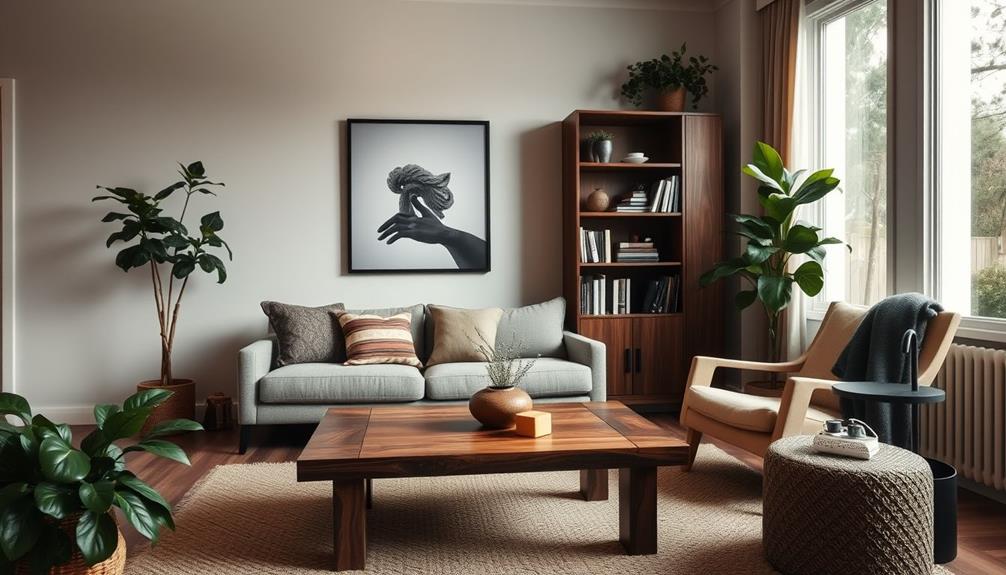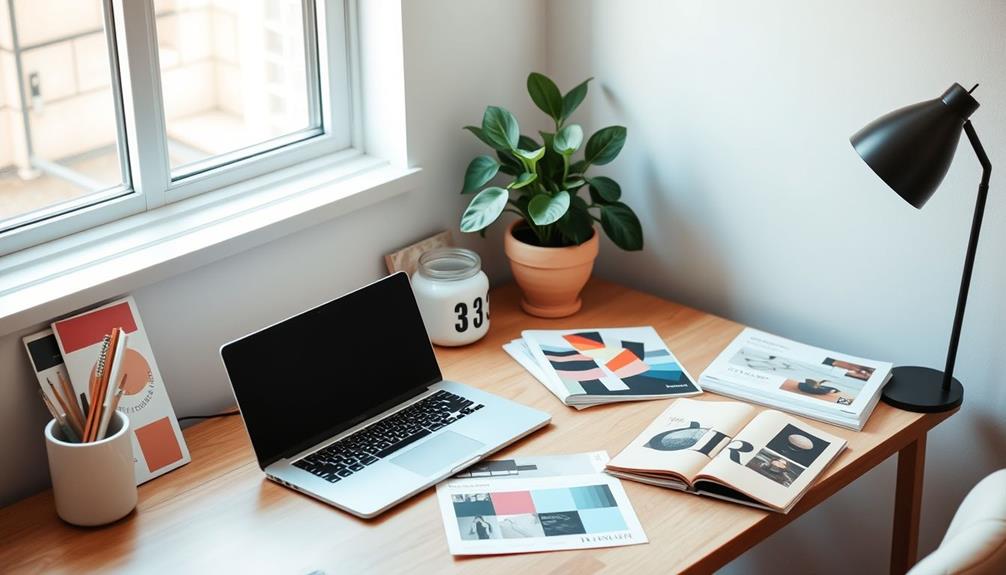Mixing wood in interior design is all about balance and harmony. Start by identifying your dominant wood tone, then match undertones for cohesion. Play with contrast by pairing light and dark woods to create visual interest. Use repetition to unify different wood elements, adding texture and grain to enhance depth. Complement your design with rugs that define spaces and consider accent pieces in contrasting materials to break monotony. Remember, integrating various wood tones and textures can lead to a stunning environment. Want to uncover more tips on creating a well-designed space with mixed woods? Check out our website for more interior design tips on how to effectively incorporate mixed woods into your living space. By following these tips, you can create a balanced and cohesive look that is visually appealing and inviting. With the right approach, mixing different wood tones can add warmth and character to any room in your home.
Key Takeaways
- Identify the dominant wood tone in your space and match additional woods with similar undertones for visual cohesion.
- Mix different wood tones for depth, balancing light woods with dark ones for contrast and interest.
- Repeat wood elements 2-3 times throughout the room to create a unified look while layering various tones for dimension.
- Incorporate accent pieces in materials like metal or rattan to break up wood monotony and introduce contrast.
- Explore DIY enhancements, such as applying fresh stain or creating a wood feature wall, to unify and personalize wood tones.
Identify Your Dominant Wood Tone
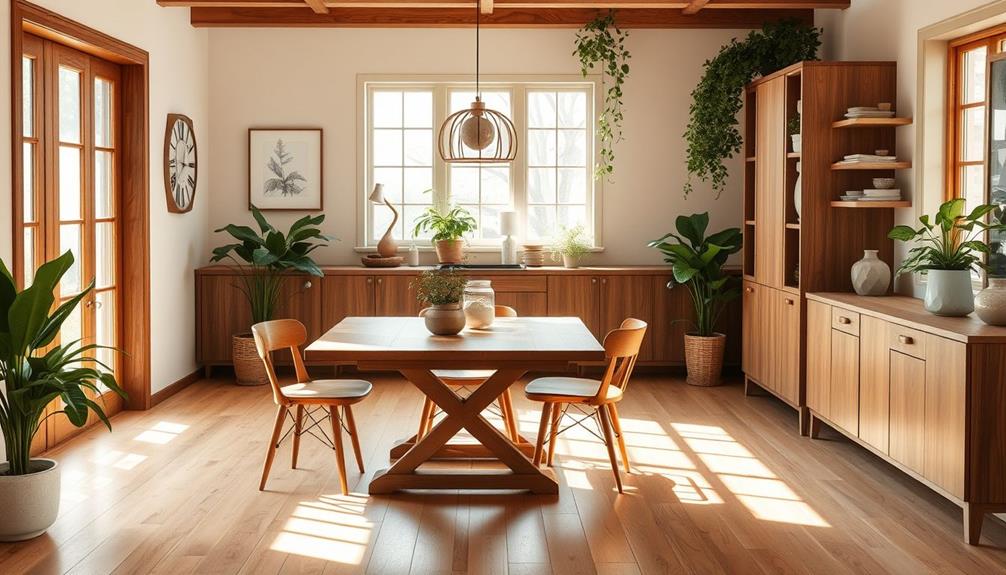
To create a harmonious interior, start by identifying your space's dominant wood tone, which often comes from the largest piece of wood, like your main furniture or flooring. This dominant wood tone serves as your primary reference point when selecting additional pieces.
Take a moment to assess any millwork, such as wainscoting or trim, as they can also influence the overall wood color palette.
Once you've established your dominant tone, use it to guide your selections for other wood elements. Aim for similar grains to avoid visual competition, ensuring cohesion and harmony in your design.
Mixing different wood tones can be beautiful, but it's essential to avoid pairing your dominant wood tone with contrasting tones that have prominent grains. This approach prevents clashing and maintains a curated aesthetic.
Match Wood Undertones
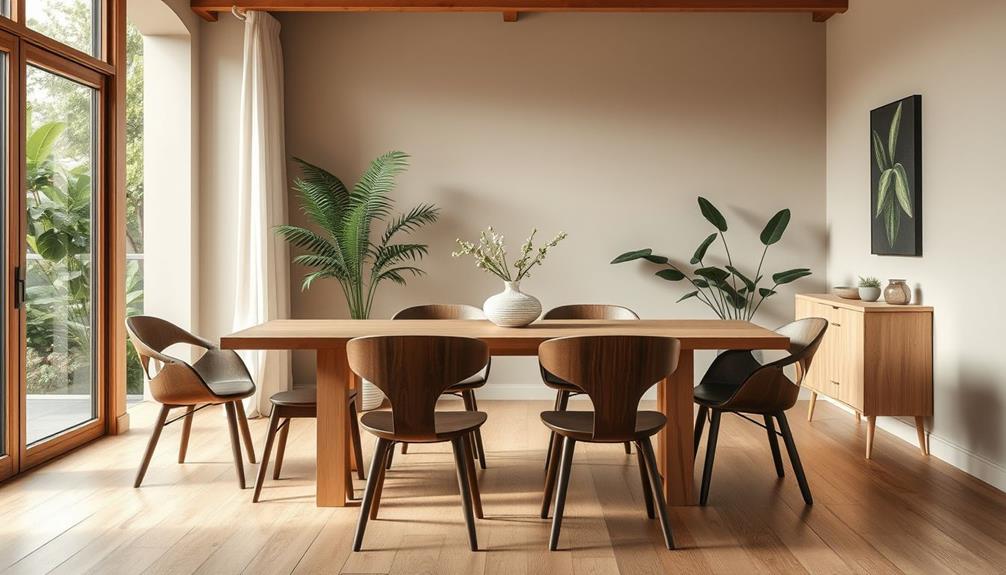
Understanding the undertones of your dominant wood tone is essential for creating a cohesive look in your interior design. When you match wood undertones, you guarantee that all your wood elements and furniture pieces work harmoniously together.
Start by identifying whether your dominant wood tone features warm, cool, or neutral undertones. If your wood has warm tones, which include hues like yellow, orange, and red, pair it with other woods that share similar warm characteristics. This approach maintains design harmony throughout the space.
Conversely, if your dominant wood tone has cool undertones, such as shades of grey, taupe, or green, you should mix it with other cool-toned woods to achieve a cohesive look.
Avoid mixing different wood tones with prominent grains or starkly contrasting undertones, as this can create visual competition and disrupt your overall aesthetic. A successful mix of wood tones relies on consistency in undertones, enhancing visual unity and contributing to a well-balanced design.
Play With Contrast
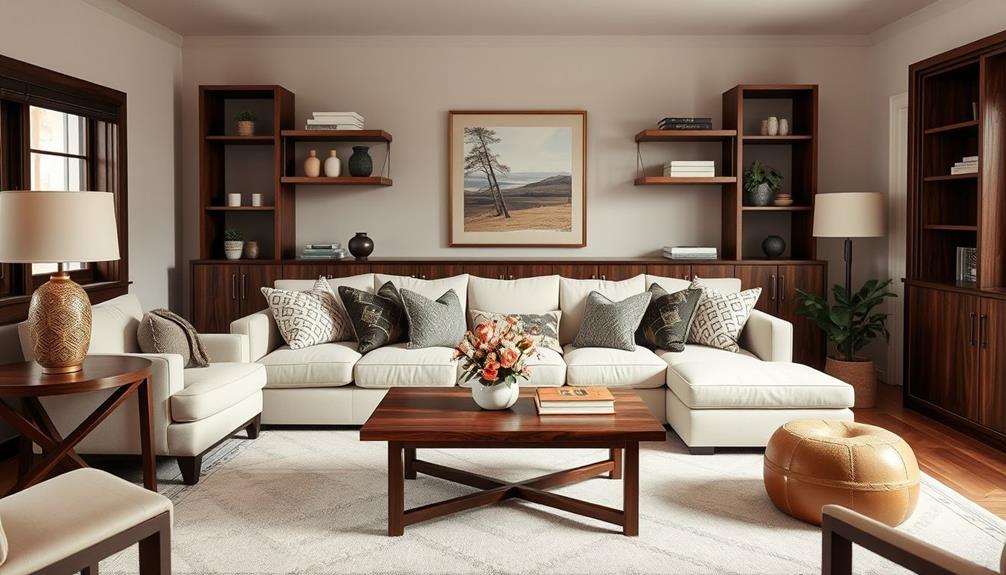
Playing with contrast in wood tones can add depth and visual interest to your interior design. By mixing different wood tones, you create a dynamic environment that grabs attention and enhances your space's overall aesthetic.
For instance, in a Modern Farmhouse Bedroom, incorporating various wood elements can enhance the serene atmosphere you desire. Here are some ideas to inspire you:
- Pair light wood floors with darker furniture pieces like walnut or ebony to introduce high contrast and fascination.
- Use light oak chairs alongside a rich mahogany table for a striking combination that elevates your dining area.
- Combine black-stained shelving with warm maple cabinetry to prevent a flat look and maintain visual excitement.
- Verify that your chosen wood tones share similar undertones—mix warm woods with other warm tones to keep the harmony intact.
When selecting your dominant wood tone, consider the overall balance of your design. Limiting bold accent pieces allows the interplay of contrasting wood tones to shine, creating an engaging atmosphere.
Create Cohesion With Repetition
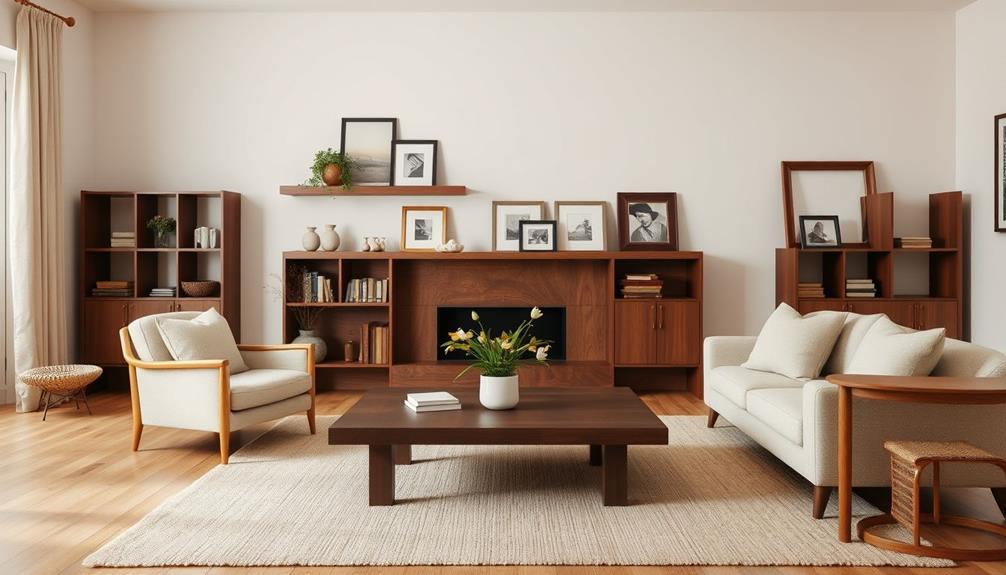
To create a cohesive look in your space, repeat wood elements 2-3 times throughout the room.
This repetition helps balance multiple tones and enhances visual harmony, making each wood tone feel intentional.
Repeating Wood Elements
Repeating wood elements throughout your space can considerably enhance its cohesion and overall appeal.
By carefully selecting and placing wood pieces, you can create a harmonious environment that feels intentional and inviting.
Here are some effective strategies to achieve this:
- Choose a consistent wood tone throughout: Aim to incorporate the same wood tone in at least 2-3 elements to establish a cohesive look.
- Layer different wood tones: While it's important to have matching wood, layering various tones can create dimension without overwhelming the design.
- Incorporate smaller decor items: Use decor pieces like bowls or picture frames that match the larger furniture to reinforce unity and enhance visual appeal.
- Select neutral walls: Neutral backgrounds can accentuate your repeating wood elements, allowing the variations to shine without creating visual clutter.
Visual Harmony Techniques
Creating visual harmony in your interior design can greatly elevate the overall aesthetic of your space. To achieve this, aim to repeat each wood tone 2-3 times throughout the room. This repetition not only enhances cohesion but also adds intentionality to your design. Incorporate small decor items, such as bowls and frames, that echo your dominant wood tone, reinforcing the overall aesthetic.
Consider the following table for effective visual harmony techniques:
| Technique | Description |
|---|---|
| Match the Undertones | Use either warm or cool tones consistently across wood pieces. |
| Group Similar Wood Tones | Minimize visual clutter by grouping tones together. |
| Layer Neutral-Stained Wood | Soften contrasts and enhance flow with neutral tones. |
| Repeat Wood Tones | Enhance cohesion by repeating tones 2-3 times. |
| Accent with Smaller Items | Use decor items to echo larger wood pieces. |
Balancing Multiple Tones
Mixing multiple wood tones in your interior design can be a rewarding challenge. To achieve visual cohesion while balancing warm and cool tones, follow these essential tips:
- Choose a dominant wood tone: Start with one primary wood that sets the atmosphere of your space. This will anchor your design and guide your choices.
- Layer neutral wood: Incorporate neutral wood tones to soften contrasts between warm wood and cool tones. This layering creates an inviting atmosphere without overwhelming the senses.
- Reinforce with repetition: Guarantee each wood tone appears at least two to three times throughout the space. Use small decor items, like bowls or picture frames, to echo your chosen tones and enhance visual cohesion.
- Group similar tones: Arrange wood pieces with similar undertones together. This minimizes visual clutter and promotes a harmonious look, especially when paired with neutral walls.
Incorporate Texture and Grain
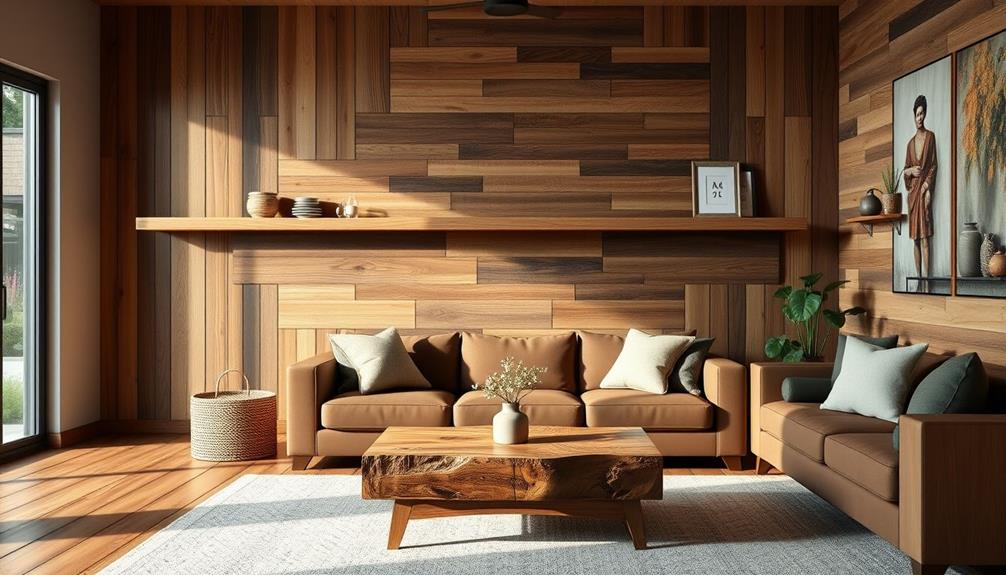
Texture and grain play an essential role in shaping the atmosphere of your interior space. By mixing wood tones and incorporating various textures, you can create a visually engaging environment. Large wood grains evoke a rustic, cozy vibe, while small wood grains offer a more refined appearance. Combining both can enhance visual diversity, adding character to your design.
To help you understand how to mix different wood grains effectively, here's a simple guide:
| Wood Grain Type | Atmosphere Created | Suggested Use |
|---|---|---|
| Large Wood Grains | Warm and inviting | Furniture, accent walls |
| Small Wood Grains | Formal and polished | Trim, cabinetry |
| Similar Wood Grains | Cohesive yet varied look | Flooring, paneling |
| Textured Elements | Depth and richness | Reclaimed wood accents |
Incorporate texture by experimenting with smooth and rough finishes. For instance, pairing a sleek table with a rough-hewn bench can create a striking balance. By thoughtfully mixing wood grains and tones, you'll achieve a dynamic space that feels both inviting and sophisticated.
Use Rugs to Define Spaces
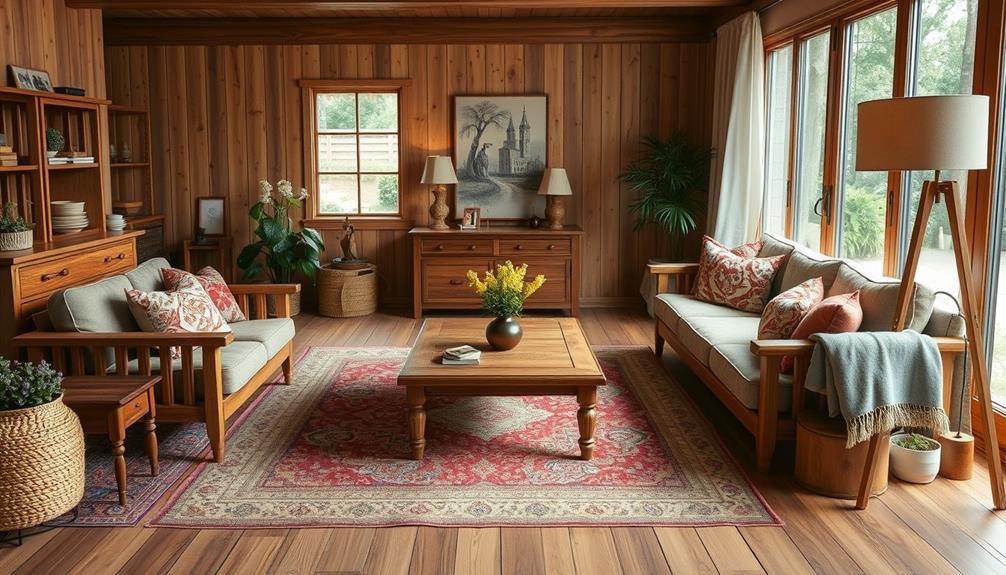
Rugs serve as powerful tools in interior design, helping to visually define spaces and enhance the flow of an open-concept layout. When you're mixing wood tones, a well-chosen rug can create distinct areas within your home while maintaining a harmonious feel.
Here are some key tips for using rugs effectively:
- Create Zones: Use rugs to delineate living, dining, and workspace areas, making each space feel intentional.
- Add Contrast: Choose rugs with contrasting colors or patterns to break up similar wood tones, adding a focal point and character.
- Complement Dominance: Verify your rug complements the dominant wood tone in the room, reinforcing a cohesive look that doesn't clash.
- Layer for Depth: Layering rugs can introduce extra texture and color contrasts, enriching your design and adding visual interest.
Utilizing warm or neutral-toned rugs can help bridge the gap between cool and warm wood tones, promoting a balanced and inviting atmosphere.
Balance Light and Dark Woods
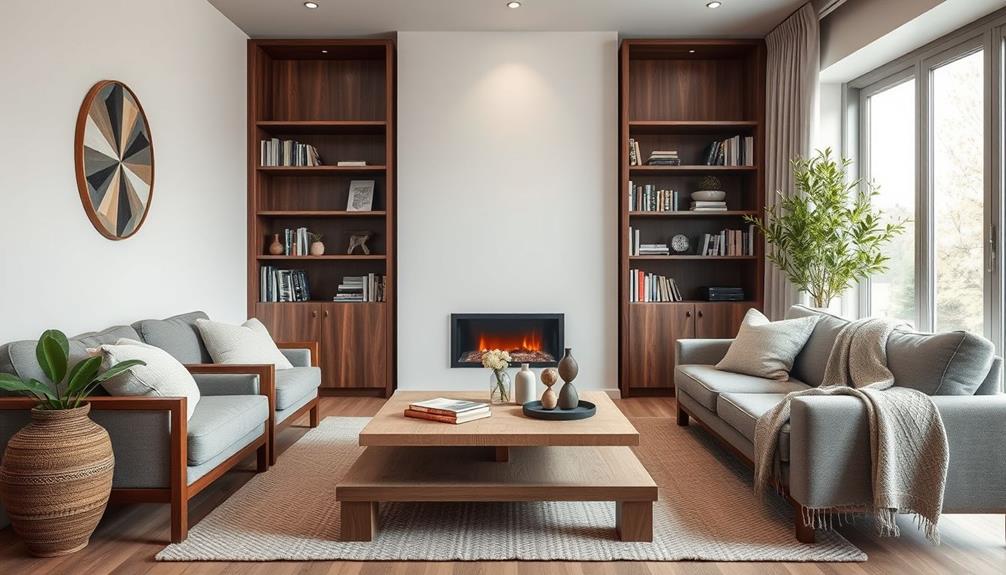
Achieving balance between light and dark woods is essential for creating a cohesive and inviting interior design. Start by selecting a light wood as your base—options like ash or maple work well. Pair it with a darker wood, such as walnut or ebony, to create visual contrast and depth.
To maintain cohesion, use a formula that incorporates light, medium, and dark woods in your space; each wood tone should appear at least two to three times.
Pay attention to the undertones of each wood; for instance, warm light woods like honey oak should complement warm dark woods like cherry to guarantee harmony.
Accessories and decor items, like lamps or picture frames, can reinforce the balance between light and dark woods throughout the room.
Enhance With Accent Pieces
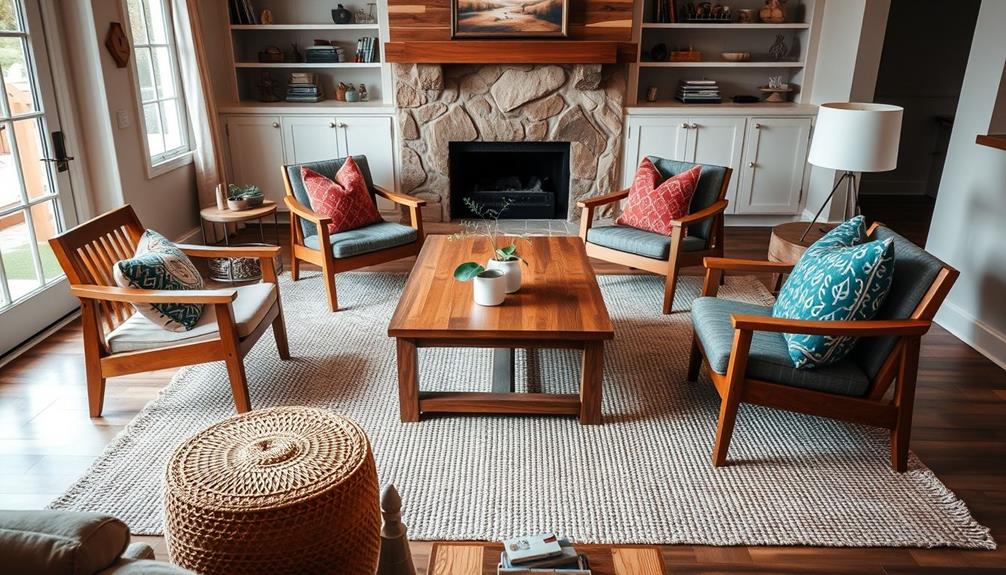
To truly elevate your interior design with wood, incorporating accent pieces is a must. These elements not only reinforce your design theme but also create visual contrast and cohesion throughout the space.
Here are some effective ways to enhance your design with accent pieces:
- Texture Matters: Choose accent pieces made from materials like rattan or metal to break up the monotony of wood. This adds visual contrast against your dominant wood tone.
- Complementary Tones: Introduce small accent pieces, such as bowls or frames, that reflect the wood tones of your larger furniture. This helps create a harmonious look.
- Layered Finishes: Use accent furniture, like side tables or stools, in a different wood tone to complement the dominant tone. Confirm this tone appears at least twice in the room for better cohesion.
- Balance with Light: In spaces dominated by dark woods, opt for light-colored wood accents to balance the heaviness and keep the room feeling airy.
Explore DIY Design Enhancements
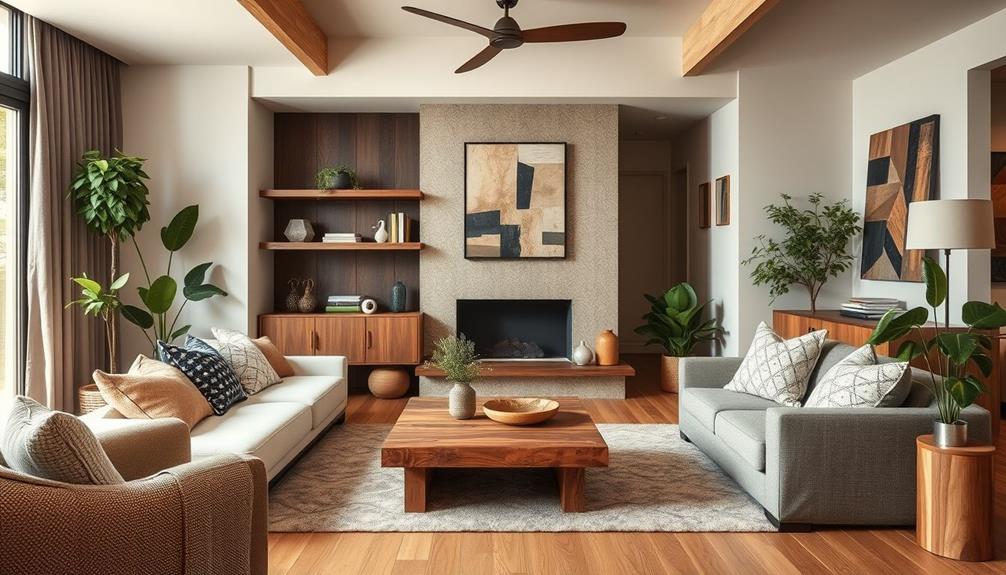
When you take on simple DIY projects, you can easily customize furniture and create unique accents that showcase your personal style.
Try applying a fresh coat of stain to unify different wood tones, or incorporate textured elements like reclaimed wood for added depth.
With a little creativity, you can transform your space into a cohesive masterpiece that reflects your vision.
Simple DIY Projects
Simple DIY projects can transform your space and bring your design vision to life. By engaging in simple tasks, you can effectively mix wood tones while adding a personal touch to your home.
Consider how the modern farmhouse decor trends emphasize the use of natural materials, which can inspire your wood mixing efforts. Here are four ideas to get you started:
- Refinish Wood Furniture: Give your old furniture a fresh look with a new stain that either matches or contrasts existing wood tones, creating a cohesive design.
- Create Custom Wood Accents: Use a mix of wood types to craft shelves or picture frames. This adds visual interest and showcases your personal style.
- Build a Reclaimed Wood Coffee Table: Consider constructing a coffee table from reclaimed wood. Its unique texture and grain can serve as a stunning focal point that ties your room together.
- Upcycle Wooden Crates: Turn wooden crates or pallets into chic storage solutions or decorative pieces. This allows you to introduce different wood tones and textures without breaking the bank.
Additionally, consider crafting a wood feature wall using various sizes and shades of wood. This can effectively unify the different wood tones in your interior design, making your space feel harmonious and inviting.
Creative Design Solutions
Exploring creative design solutions can breathe new life into your home and enhance the beauty of mixed wood tones. Engaging in DIY projects allows you to personalize your space while effectively experimenting with mixing wood tones.
Start by creating custom shelves or accent pieces that showcase various wood furniture styles, adding contrast and depth.
Utilizing mood boards can help you visualize how different wood tones and textures interact in your interior design. Before making purchases or changes, this step guarantees you're on the right track.
Simple enhancements, like upgrading cabinet hardware or adding crown molding, can elevate your overall design while seamlessly integrating various wood tones.
Incorporating reclaimed wood elements into your DIY projects adds character and serves as a focal point that harmonizes with other wood tones in the space.
Layering textures through materials like rattan or bamboo enhances the visual appeal, creating a rich and inviting atmosphere.
These creative solutions not only improve your interior design but also allow you to express your personal style through thoughtful mixing and matching of wood tones.
Conclusion
Mixing wood in your interior design can transform your space in unexpected ways. By identifying your dominant wood tone and experimenting with different undertones, you'll create a harmonious yet dynamic environment. You might find that a touch of contrast or a unique accent piece sparks joy, just like discovering an old photograph that brings back a cherished memory. So go ahead, embrace the beauty of wood, and watch how it brings your design vision to life, one piece at a time!
